Abstract
The development of social media in the 21st century has changed the quality and level of political participation of all public policy entities. Every second an enormous amount of network data is produced in the online space leading to the creation and transformation of discursive fields in both online and offline space. A feature of online communication between top journalists and users of journalistic content is a linguistic pattern. To analyze the linguistic patterns of communication the social accounts of Alexei Venediktov, Vladimir Solovyov, Vladimir Pozner, Margarita Simonyan and Ksenia Sobchak (according to the Citation Index of the Medialogia company for the period January 1-30, 2020; database is more than 54 thousand sources) on VK, Facebook, Instagram, Twitter were chosen. The total audience of these journalists was about 6 million direct subscribers (indirect consumers of journalistic content are of about 60 million users). The socio-political context of the formed data sets was the reaction of journalists and the public to the Address from the President of Russia V.V. Putin to the Federal Assembly on January 15, 2020. The resulting data sets were subjected to network analysis, linguistic-discursive analysis, folksonomic analysis. As a result some conclusions were drawn about what language-discursive features characterize the posts of top journalists in popular social networks; how their linguistic patterns are characterized; how the content created by journalists differs in different social networks; what is the specificity of these differences; how the political context affects their linguistic patterns; how linguistic patterns of journalists influence online communication models.
Keywords: Communicationlinguistic patternsmedialinguistic analysisnetwork linguisticsonline spacesocial online accounts
Introduction
Every day in the online space 3 billion gigabytes of various content are generated, transmitted and played back, users send 195 billion emails, view and post 5 billion video files on YouTube, carry out 4 billion requests to search engines (“Trends in monetization of content…”, 2019). Media Consumption in Russia – 2019, www). Online space has become an integral part of social space making it complex (in terms of the variety of data and the methods of its production and reproduction, including BigData), a non-linear, multidimensional object of study - a global space which is a network of intersecting discursive fields (formed by users, social networks and / or network communities) (González, 2018), which are both a reflection of social reality and an instrument for its construction through the production of linguistic patterns/
Every second an enormous amount of network data is produced in the online space, the influence potential of which is difficult to assess or predict (Ryabchenko et al., 2019). Digital technologies form a new culture of interactions (collaboration, the exchange of information and resources, interactivity and multimedia) and thus allow the formation of a new type of content in form, content, linguistic and cultural features and implicit meanings. Collective consciousness in view of the functioning of network communities in the “filter bubble” is becoming the dominant form of “thought” in the modern world: individuality is no longer a virtue and divergence, dissent, the do-it-yourself approach and “independent investigations” are perceived as a destructive component of discursive interaction (Benamara et al., 2018; González-Bailón & Wang, 2016), as it leads to tragic consequences, threatens security and undermines trust in state power, moral standards which carries a destructive potential for influencing the development of socio-political systems in the modern world.
Problem Statement
The development of social media in the first quarter of the 21st century has changed the quality and level of political participation of all public policy entities. The function of shaping the political agenda was shared by media, journalists, media personalities, well-known public figures, civic activists and top bloggers who can create and broadcast linguistic patterns that are filled with modern mass media sources, reflected in posts, reposts and comments of fans in real life and subscribers on social networks and the blogosphere (Feezell, 2018; Ott, 2017). A feature of communication between top journalists and users of journalistic content is a linguistic pattern - a way of presenting the views of a journalist, marking the text, highlighting the most important, in their opinion, information which focuses on points that require attention and discussion. Linguistic patterns produced by Russian journalists in their online-accounts require study and analysis due to their ability to create and transform discursive fields in both online and offline spaces (Jones et al., 2015; Solmaz, 2014). The consumption of linguistic patterns by both ordinary users and representatives of social media under the “power” influence of the discursive field becomes a determining factor in the process of development and adoption of individual / collective decisions, the implementation of which forms a particular social action (Katermina & Gnedash, 2018; Rodout, 2018).
The average Russian spends almost half a day on online interaction, including more than half of this time on popular social media. At the same time the younger the generation, the greater the level of confidence in social media as the main source of information compared to traditional media (Frolov, 2020).
Russian journalists are the main influencers of the modern news and information field both in offline and online spaces. The main trend in the development of the information and news field is as follows: journalists generate content in their accounts on social networks; then this content is cited and distributed by users and official media. The point of view of top journalists is becoming the dominant way in which citizens perceive social and political events in online and offline media. Linguistic patterns produced by popular Russian journalists in their online accounts are consumed by users and the media, thereby influencing the political agenda, the development of public opinion and the formation of socio-political behavior of citizens.
Thus, information and communication technologies transform social reality and pose new research questions for science related to how exactly the discursive fields and the content contained in them, and the linguistic patterns produced by them initiate a social action that affects the development and transformation of socio-political systems of modern states.
Research Questions
The main research task was to find answers to the following questions:
1. What linguistic-discursive features are characterized by the posts of top journalists in popular social networks?
2. How are the linguistic patterns produced by top journalists in the online space characterized?
3. Does the content created by journalists differ on different social networks? What is the specificity of these differences depending on the specifics of the social platforms themselves?
4. How does the political context influence the linguistic patterns produced by top journalists in the online space?
5. What are linguistic patterns of journalists and their impact on communication models in the online space?
Purpose of the Study
It is the network forms of interaction between the journalist and his audience that seem to us a relevant subject for research since this model of communication is becoming a tradition for a fundamentally new type of communication in the online space. The accounts of top journalists in Russia that we study reflect a certain type of social behavior in response to the political agenda. Each journalist as a public and public figure interested in publishing relevant content is active in social platforms, using and guided by his own style of presentation of material and his own opinion which provokes a public reaction. In turn, the consumption by users of the linguistic patterns created by the most popular journalists leads to the formation of certain social behavior outside social networks and can become a determining factor in the process of developing and making constructive / destructive individual / collective decisions in a city, region, country.
Research Methods
To analyze the linguistic patterns of communication in the social accounts of top Russian journalists (according to the Citation Index of the Medialogia company for the period January 1-30, 2020) (TOP-15 most cited journalists…, 2020) We selected the accounts of Alexei Venediktov, Vladimir Solovyov, Vladimir Pozner, Margarita Simonyan and Ksenia Sobchak on VKontakte, Facebook, Instagram, Twitter (the sequence is indicated according to the rating of popularity of social networks in Russia) (“Social networks…”, 2020). The socio-political context of the formed data sets was the reaction of journalists and the public to the Address to Federal Assembly by the President of the Russian Federation V.V. Putin on January 15, 2020 (President of the Russian Federation V.V. Putin's Address to Federal Assembly of January, 2020). Next, all posts of these journalists were selected from accounts in the specified social networks VKontakte, Facebook, Instagram, Twitter. The obtained data sets were subjected to network analysis, linguodiscursive analysis, folksonomic analysis.
The analyzed top Russian journalists have not only the highest Citation Index (the media database of the Medialogia system includes more than 54 thousand sources: TV, radio, newspapers, magazines, news agencies, Internet media), but also the widest Internet audience of users and Subscribers: Alexey Venediktov – approx. 1 million subscribers, Vladimir Solovyov – 1.3 million subscribers, Vladimir Pozner – approx. 200 thousand subscribers, Margarita Simonyan – approx. 1 million subscribers, Ksenia Sobchak – 1.4 million subscribers. Given the network nature of communication in the online space and the interaction of the studied journalists with other influencers, the approximate number of consumers of the content produced by them (top journalists) increases by 10 times: the estimated number of users who read the posts below is estimated at 60 million citizens. These factors provide these journalists with 2 channels of influence on public opinion and the political agenda: formal channel –through the media; informal channel – through users and subscribers.
Findings
1. Linguistic communication patterns of Alexei Venediktov, Vladimir Solovyov, Vladimir Pozner, Margarita Simonyan and Ksenia Sobchak in VKontakte social online accounts:
- top Russian journalists Aleksey Venediktov, Vladimir Pozner, Margarita Simonyan and Ksenia Sobchak do not operate on such a social platform as Vkontakte, there are no pages with their name and the communities represented by Vkontakte are not organized by the journalists themselves but by their fans who stopped active publishing activities;
- Vladimir Solovyov’s VK account is inconsistent and cannot be a reliable field for collecting and processing data
2. Linguistic communication patterns of Alexei Venediktov, Vladimir Solovyov, Vladimir Pozner, Margarita Simonyan and Ksenia Sobchak in Facebook social online accounts:
- the accounts of Alexei Venediktov, Vladimir Solovyov and Ksenia Sobchak on Facebook are not supported or the information is updated irregularly;
- Vladimir Pozner’s Facebook account basically consists of hyperlinks to his publication on the https://pozneronline.ru/ resource (Figure
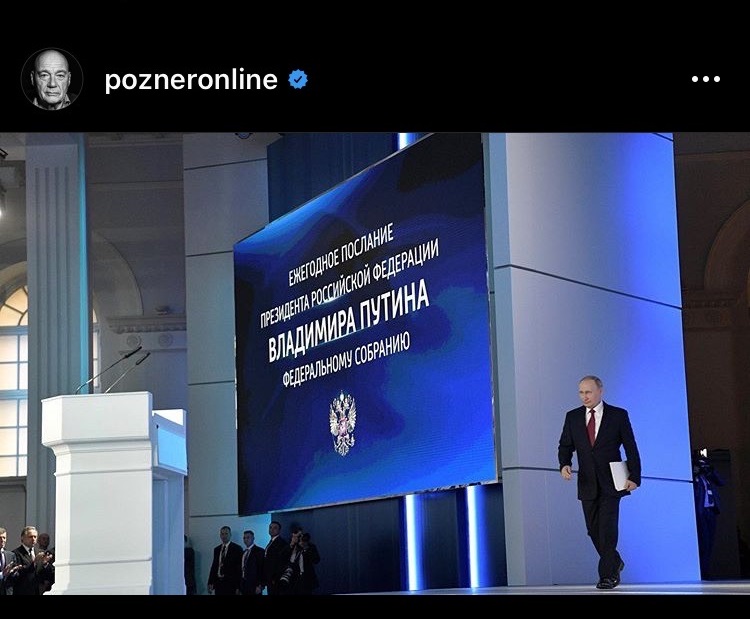
-Margarita Simonyan’s Facebook account is basically retweets of her own messages from Twitter accounts and reposts of articles and posts of other users of Facebook she is interested in.
3. Linguistic communication patterns of Alexei Venediktov, Vladimir Solovyov, Vladimir Pozner, Margarita Simonyan and Ksenia Sobchak in Instagram social online accounts:
- Alexey Venediktov maintains a personal online Instagram account, posts are not directly related to political issues and do not reflect the political agenda;
- In his posts on Instagram, Vladimir Solovyov quotes excerpts from the message of President V.V. Putin without expressing his personal opinion and attitude;
- Vladimir Pozner usually begins his posts on Instagram using the first person personal pronoun “I”, thus strengthening his position from the very beginning. His posts are built logically – the introduction, the main part which clearly sets out several arguments “for” and “against”, conclusions. The posts about the Address of the President of the Russian Federation begin with criticism of the work of the government Pozner uses vocabulary with a negative connotation: “dissatisfied” and “resign”. Next comes criticism of the work of the former prime minister expressed explicitly. Pozner neither openly criticizes the personality of the prime minister himself nor his work. He just talks about the position. The next argument is a description of the personality of the new prime minister. The characteristic features are positive. The units that are used in the description are full of reclamation coloring: “sensible, active, concrete.” The work of the institution under his leadership is rated as “excellent.” The final argument in this post is the constitutional changes proposed by the President. Pozner describes them as “reasonable,” shifting the focus from emotions to business and work processes. He concludes his post by calling both speech and conclusions “correct”, thus agreeing to the above;
- Margarita Simonyan's posts on Instagram are concentrated around the personality of the candidacy of the new Prime Minister (the post is preceded by a photograph of the new Prime Minister). It gives extremely positive characteristics: clear, smart, decent, modern, incredibly professional, amazing manager. She assures that this is the best choice, with which she congratulates the entire population.
- the sentence that Ksenia Sobchak opens her Instagram post is directly related to the photograph (Figure
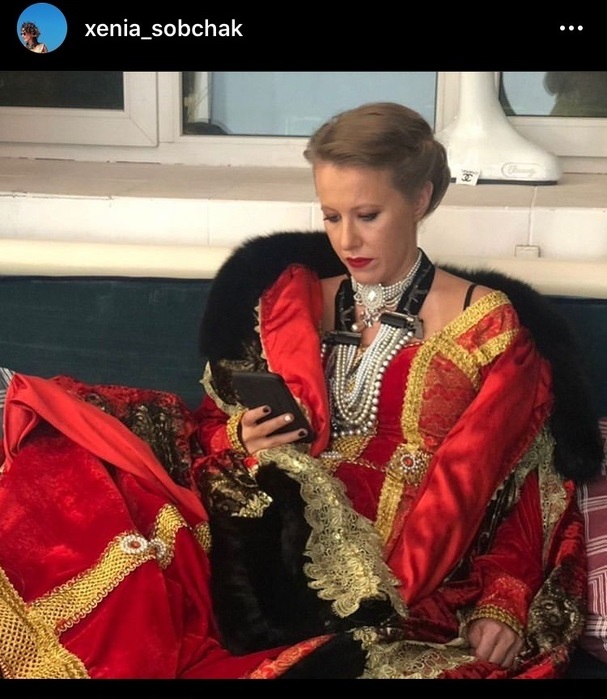
4. Linguistic communication patterns of Alexei Venediktov, Vladimir Solovyov, Vladimir Pozner, Margarita Simonyan and Ksenia Sobchak in social online Twitter accounts:
4.1 Aleksey Venediktov uses a pun in his posts on Twitter: with a reaction to Smirnov’s post “So exciting before the President’s address”, he combines two surnames: Smirnov + Mironov (Smironov) and also uses a link to the children's reading room (Sea is worried – once: Smironov is worried - once). The logical plan should be also noted that A. Venediktov “builds” after listening to the President’s address putting everything in a clear and concise form:
Introducing the colloquial “so” in the first word, A. Venediktov sets the reader to a certain tonality and sets out his thoughts briefly and clearly. Moreover, in the end he draws the conclusions that he comes to after listening to the President’s report.
Another way of organization of the posts of this journalist can be attributed to a personal comment in brackets which creates a double effect and helps to reveal the image of a journalist: a logically thinking person (
In the next post, a comment in brackets contributes to creating a contrast that points to the President’s preferences for the former prime minister: “
Comparison is also present in the saying “the system a la Peter the Great”, as well as the stable expression “The Eye of the Sovereign”, for the understanding of which background knowledge and vertical context are necessary.
The allusion to the
Comparisons are also made by mentioning the hobby of the new Prime Minister and the new US Ambassador to Moscow (Figure
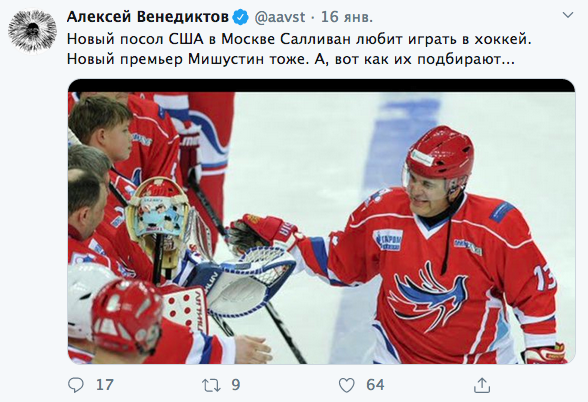
It is also worth noting the use of the words which Venediktov uses by naming a new position of Dmitry Medvedev (proxy vice president): proxy – an authorized representative; usually this term is used in computer technology and means an intermediate server (a set of programs) in computer networks that acts as an intermediary between the user and the target server (in this case, both sides may or may not know about mediation), which allows clients both to perform indirect requests (receiving and sending them through a proxy server) to other network services and receive responses).
Characteristic features of A. Venediktov's posts on Twitter are links to his interviews as well as video screens that indicate the names of the radio stations where these interviews took place. Giving a hyperlink, the journalist reposts quoting a key sentence: “A. Venediktov: Putin is strengthening the power component. What is a Security Council? This is the current Politburo.” An interesting linguistic device is the “information - question - answer” scheme which also forms a special linguistic pattern of this media personality.
4.2 The stylistic features of the linguistic patterns of Vladimir Solovyov on Twitter can be described as follows: the use of graphic techniques in the design of their posts (capital letters).
To identify citations, the journalist puts the surname either at the beginning: “PUTIN: A SERIOUS TALK ABOUT STABILITY AND SECURITY OF THE WORLD ORDER”, or after the quote itself: “THE MOST IMPORTANT IS TO REMOVE THE BARRIERS FOR BUSINESS AND TO REDUCE ITS SENSE” IT IS BEFORE (MISHUSTIN)”. He is also characterized by the use of an ordinary font: "Factions will support the candidacy of Mikhail Vladimirovich Mishustin for the post of Prime Minister of the Russian Federation."
V. Solovyov uses symbols (lightning or exclamation mark) to indicate important messages denotes symbols.
Visualization as a technique is also used by a journalist (Figure
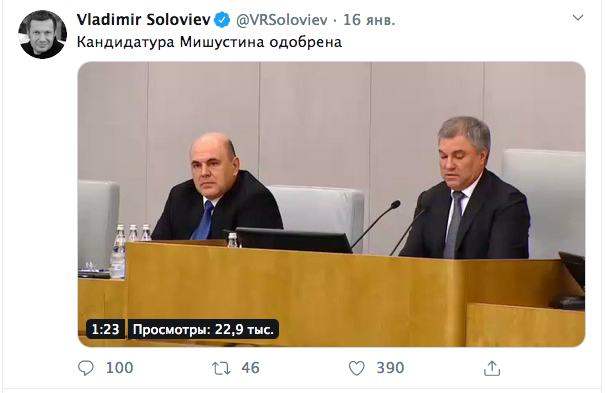
Vladimir Solovyov also uses hyperlinks as a “side view”: for example, the opinion of the “main Norwegian tax specialist” about Mishustin is shown. Thus, Soloviev shows an objective picture of what is happening.
It is also worth noting a hyperlink to your own interview: a photograph of a journalist and a key phrase, stylistically bright and catchy:
4.3 Vladimir Pozner’s Twitter account (also like a Facebook account) basically consists of hyperlinks to his publication on https://pozneronline.ru/, announcements of his own television shows or Pozner’s interview with other journalists in traditional media (magazines, newspapers, TV shows).
4.4 Margarita Simonyan’s Twitter account is filled with monosyllabic comments “along the way”. A combination of formal and informal styles is observed:
To express her own opinion, the journalist uses evaluative vocabulary (“the strongest message of all time, the best solution”), hyperbolization (“you have no idea how many people have called me now”).
In her posts Simonyan gives a peculiar stylistic characteristic to the Prime Minister describing him more like a situation not a person:
In one of the posts, she notes a detail that implicitly also characterizes the Prime Minister:
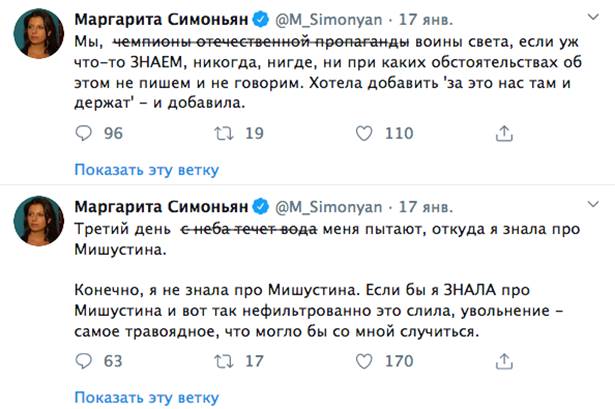
The use of a special font characterizes M. Simonyan as a principled and bold journalist (Figure
4.5 Ksenia Sobchak's Twitter account is inconsistent and cannot be a reliable field for collecting and processing data.
Conclusion
As a result of the study of linguistic patterns of communication in social online-accounts of top Russian journalists we came to the following conclusions.
The social network and VKontakte accounts are not actually used by top Russian journalists to form and display public political discourse and the political agenda.
The social network and Facebook accounts are used by Russian journalists mainly for announcing posts (programs, interviews, etc.) in other social and traditional media as well as for reposting articles and posts of other Facebook users who are interested in them.
Instagram is the most popular among top Russian journalists for publishing personal (about myself and my daily life) and personal (what I like at the moment; my opinion on something; my photos) information.
Twitter accounts are used by Russian top journalists to the maximum extent as a political digest with an active display of their own political position and for the formation of their own linguistic communication patterns in the online space.
The main characteristics of the linguistic patterns of communication of journalists in social online accounts are: a logical plan of posts; personal comment in brackets; allusions to modern and historical facts and famous events; use of terminology to illustrate thoughts; hyperlinks used by the described scheme “information - question - answer”; the use of graphic techniques in the design of their posts (capital letters); the use of symbols to attract attention; visualization y means of photographs; hyperlinks as a “side view”; combination of formal and informal styles in the description of key events; the use of emotional vocabulary and hyperbolization.
The accounts of top journalists in Russia reflect a certain type of social behavior in response to the political agenda. Each journalist as a public figure interested in publishing relevant content is active in social platforms, using and guided by his own style of presentation of material and his own opinion, which provokes a response from society, further requiring further study depending on the specific role of the user in process of political communication.
Acknowledgments
The research is given a financial support by The Russian Foundation for Basic Research (Department of Humanitarian and Social Science), the research project № 20-012-00033 “Linguistic models of sociopolitical communication in online space: discursive fields, patterns and hybrid methodology of network data analysis” (2020 – 2022).
References
- Benamara, F., Inkpen, D., & Taboada, M. (2018). Introduction to the Special Issue on Language in Social Media: Exploiting Discourse and Other Contextual Information. Computational Linguistics, 44(4), 663-682. https://doi.org/10.1162/coli_a_00333
- Feezell, J. T. (2018). Agenda Setting through Social Media: The Importance of Incidental News Exposure and Social Filtering in the Digital Era. Political Research Quaterly, 71(2), 482–494. https://doi.org/10.1177/1065912917744895
- Frolov, D. (2020, April 2). How media consumption and content are changing. Digital Trends 2019 in quotes and comments. Sostav. https://www.sostav.ru/publication/skuchno-ne-budet-kak-menyaetsya-mediapotreblenie-i-vidy-kontenta-v-tsitatakh-i-kommentariyakh-36583.html
- González-Bailón, S., & Wang, N. (2016). Networked discontent: The anatomy of protest campaigns in social media. Social Networks, 44, 95-104. https://doi.org/10.1016/j.socnet.2015.07.003
- González, F. (2018). The age of perplexity: rethinking the world we knew. Penguin.
- Jones, R. H., Chik, A., & Hafner, C. A. (2015). Discourse and digital practices: Doing discourse analysis in the digital age. Routledge.
- Katermina, V. V., & Gnedash, A. A. (2018). Obrazovanie politicheskogo konteksta v onlajn prostranstve: strukturno-setevoj i lingvisticheskij analiz sovremenny`x social`ny`x dvizhenij [The formation of political content in the online space: structural-network and linguistic-discursive analysis of modern social movements (based on Women’s March)]. Political Linguistics, 4(70), 87–96.
- Ott, B. L. (2017). The Age of Twitter: Donald J. Trump and the Politics of Debasement. Critical Studies in Media Communication, 34(1), 59-68. https://doi.org/10.1080/15295036.2016.1266686
- Rodout, T. N. (2018). New Directions in Media and Politics. London: Routledge
- Ryabchenko, N. A., Malysheva, O. P., & Gnedash, A. A. (2019). Menedzhment politicheskogo kontenta v social`ny`x setyax vo vremya vy`bornoj kompanii v e`ru post pravdy` [Management of political content in social networks during the election campaign in the post-truth era]. Policy. Political research, 2, 92–106. https://doi.org/10.17976/jpps/2019.02.07
- Social networks: a list of popular in Russia. (2020, April 5). https://relevant.ru/blog/1081/
- Solmaz, O. (2014). Discourse of Twitter and social media: How we use language to create affiliation on the Web. CALICO Journal, 31, 412-414.
- Trends in monetization of content on the Internet. Media Consumption in Russia (2019, November 12). https://www2.deloitte.com/ru/ru/pages/technology-media-and-telecommunications/articles/media-consumption-in-russia.html#
- TOP-15 most cited journalists (2020, January 15). https://www.mlg.ru/ratings/
- President of the Russian Federation V.V. Putin's Address to Federal Assembly of January 15, 2020 (2020, February 2). http://kremlin.ru/events/president/news/62582
Copyright information

This work is licensed under a Creative Commons Attribution-NonCommercial-NoDerivatives 4.0 International License.
About this article
Publication Date
20 November 2020
Article Doi
eBook ISBN
978-1-80296-094-5
Publisher
European Publisher
Volume
95
Print ISBN (optional)
-
Edition Number
1st Edition
Pages
1-1241
Subjects
Sociolinguistics, discourse analysis, bilingualism, multilingualism
Cite this article as:
Gnedash, A. A., Katermina, V. V., & Nikolaeva, M. V. (2020). Linguistic Patterns Of Communication In Social Online Accounts Of Top Russian Journalists. In Е. Tareva, & T. N. Bokova (Eds.), Dialogue of Cultures - Culture of Dialogue: from Conflicting to Understanding, vol 95. European Proceedings of Social and Behavioural Sciences (pp. 140-151). European Publisher. https://doi.org/10.15405/epsbs.2020.11.03.16
